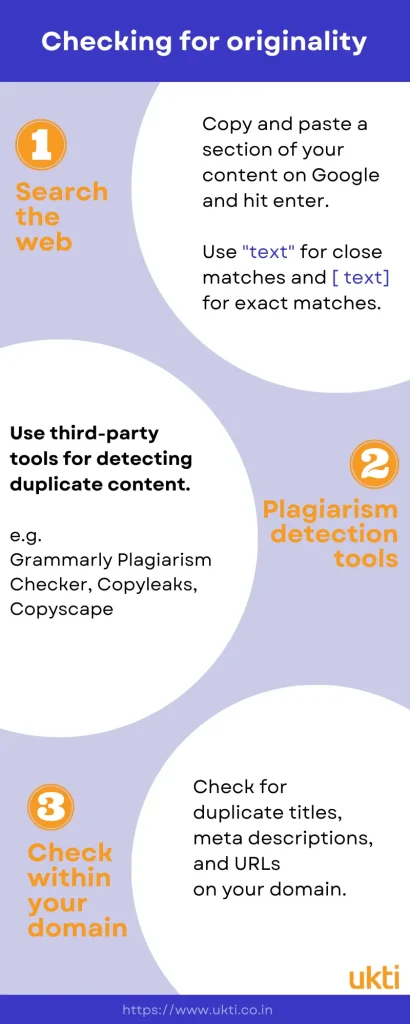As a content writer, I need to write tons of marketing content every week. And before I deliver, I need to ensure that what I write is accurate, comprehensive, and 100% unique. In other words, high-quality original content.
Originality is one of the most important characteristics of quality content, especially when such content is created with the goal of establishing your brand’s image as a leader in the niche. Besides, Google also takes content originality into account while handing out SEO points. If you publish content that is original, it has a better chance of ranking higher.
Here’s the catch: it is not possible to write something that is all-original. All content is inspired, curated, or re-purposed.
So, how can you write something unique that delivers value to your readers and stand out in the sea of content? Let us explore.
What is original content?
Original content is content that hasn’t appeared on the web in the same language, tonality, and format. It does not have to be 100% new, but it has to be *different enough* to make you stand out.
While this explanation is simple, it can be challenging to get it right. And who knows it better than those who write for a living?
No content piece is 100% original!
As writers:
- We all take inspiration from somewhere (haven’t you used something similar to an ad jingle you once heard? Or the one metaphor you read in that Enid Blyton book when you were 7?)
- We re-iterate information that has been published on the web. (And do we duly cite them as our references!)
- We include quotes, adages, and other commonly used phrases in our content. (Because we cannot twist a direct quote. Or, write something badly paraphrased like ‘consuming one apple every 24 hours will drive away the doctor.’)
- We may plagiarize unintentionally.
- We may not realize that we have written this before. (That is until you start editing it and experience deja vu.)
Just like writer’s block, these situations are unavoidable. The only way to bypass them is to submit a blank document, and even that has been published before.
But the good news is that your content does not have to be completely unique. As long as you present it in your own unique way, it works.
How do I know if my content is unique?
Checking for plagiarism, similarities, and paraphrasing in your content is a helpful way to understand where you may be too close to your source.
Before you hit that publish button, use these ways to check content originality:

1. Search the web
If you feel like a section of your article is too close to the references you have used (or if your intuition says you might have read it somewhere), perform a Google Search. You can enclose the phrase in double quotes to find similar matches or square brackets to find exact matches.
2. Use third-party tools
There are countless plagiarism-checker tools available on the web that match your text against published works to check for similarities. Paid tools offer more precision than free tools. Some tools we use at Ukti are Grammarly Plagiarism Checker and CopyLeaks.
CopyLeaks not only tells you about exactly matching content but also highlights heavily paraphrased content.
3. Check for similar content within your domain
Google’s search algorithm also considers duplication within a domain. This isn’t limited to the main content on your webpage but extends to your meta descriptions, titles, and even page URLs. One way to avoid this is to be careful while publishing your content and using canonical URLs. If you use boilerplates at the end of each blog, make sure that they aren’t too lengthy.
The importance of creating original content
Why should you spend time and energy creating original content when no content is 100% unique anyway? Here are four reasons why.
#1 Original content = more credibility = more authority
When you give your readers something no one else can, you stand out. Plus, when people understand that you are earnest in your content marketing efforts, they tend to trust your brand.
If you publish content that is copied or too similar to your competitors, you risk being labelled as a copycat. Your audience may feel duped and believe that your products and services aren’t worth it either.
#2 Give readers something new, and they are more likely to share it
Think of the content that has gone viral in the past: memes, dance videos, songs, news articles, or opinion pieces. What is the one thing that is common among all of them?
Originality!
When readers find something new that gets their attention, they are tempted to share them with other people. It is a eureka moment – look what I found! I bet you haven’t seen this before.
Now, you don’t necessarily want to make your content go viral among the masses. But you can surely take a lesson from this and create new content that your audience will be tempted to share.

#3 Original content is good for your SEO health
This is how Google handles duplication: It pushes the oldest content to the top and leaves the new, copied content at the bottom. So, if you have scraped content from published pages, your rankings will remain bad. Worse, you will attract copyright claims.
According to Google’s search quality raters’ guidelines, ‘Very High-Quality Main Content’ is accurate, comprehensive, and original. And it makes sense.
When it comes to Google Search, the algorithm has changed drastically over the past decade. The focus has shifted from keywords and links to user experience. How does your content make users feel? Does it offer something of value? Is it helpful? Is it high-quality?
If elevating your SERP ranks is your main concern, it is best to take the time to craft original blog posts and deliver an exceptional user experience.
#4 By publishing original content consistently, you emerge as a thought leader
As your audience develops trust in your brand, shares your content, and finds you frequently appearing in their search results, you have the perfect setting to establish yourself as a thought leader in your niche. And with Google’s recent ‘helpful content’ update, being a thought leader can be a big win!
Besides, Google’s search quality evaluators also consider the EAT guidelines (Expertise, Authority, Trust) while evaluating your content. While this isn’t a direct ranking factor, adhering to the EAT guidelines will ensure that your content ranks high in the long term.
EAT the world!
Read more about Google’s EAT guidelines on Search Engine Journal.
How to create original content?
Creating original content is easier said than done. But even though it is a challenging task and requires elbow grease, you will not go wrong if you keep these 5 simple tips in mind.
If you are a visual learner, keep this picture handy:

1. Write from your experience
Just like I am writing this blog, drawing upon my experiences and observations as a full-time content writer at Ukti.
2. Let your employees share their thoughts
Your colleagues and employees also have a unique outlook on your product, industry, and nice. Give them a laptop and some coffee, and let them run wild! (Or, interview them if that floats your boat.)
3. Craft a unique writing style
Jeffrey Daniel once came up with a dance step that involved sliding back on your feet. Michael Jackson took inspiration from him, refined it, named it ‘the moonwalk,’ and did it with perfection. Even today, the term moonwalk is synonymous with his name. Why? Even though a lot of people can slide on their feet, nobody does it like him.
That’s what you have to do: write what has been written, but do it in your own unique style.
4. Dig deeper and go wider with your research
When writing for a ‘boring’ or ‘common’ topic, go where other writers haven’t ventured yet. Explore uncharted territories such as case studies, research papers, news articles, and maybe some blogs on the second page of Google.
5. Get inspired from, well, wherever you can
Why read something unrelated to your product? Well, why not? Inspiration can come in many forms.
Read interesting content pieces even if they aren’t relevant to your topic, and you may be surprised to find yourself highlighting sentences that stand out to you. (This isn’t an invitation to go read Buzzfeed articles and procrastinate, btw.)
A word on paraphrasing and patchwriting
Everybody paraphrases because, well, everyone needs to. This is true when writing about something which is factual, based on research by other organizations, or just something very niche and technical.
However, paraphrasing, like writing, is also an art.
When you paraphrase some parts of a published content piece, take care to avoid patchwriting. Patchwriting means making slight changes in the original text and passing it off as your own. Patchwritten content is basically plagiarised content and does not have any value in your overall content strategy.
If you find that your content pieces are full of patchwriting, don’t worry. Instead, use it to your advantage. Patchwriting is a good way of understanding the essence of your primary source. So, it is alright if it makes its way into your first draft. Once you re-read your content and actually grasp the message, it becomes easier to give it your own spin and paraphrase it.
Repurposing content: yay or nay?
So, you’ve written a killer blog post. And now, you want to repurpose it as a listicle, infographic, video, or interactive image. Is repurposing content the same as plagiarising content? Not at all! As long as you follow a different format, it is considered unique.
Also Read: Google: Same Content in Different Formats is Not Duplicate.
The bottom line
Are you ready to energize your content strategy with high-quality, original content? Go ahead! Use the tips given in this blog and start creating.
Welcome inspiration from every source you can find. Read the news, watch advertisements, read our blogs, and go visit your Chrome Bookmarks. (Yes, we all have a list of blogs-to-read which are starred and forgotten.)
Then take that old wine, add a dash of your own flavour, package it into your brand’s unique bottle, and serve it up with confidence.
About the Author


13 thoughts on “Why Original Content Matters Now More Than Ever (and How to Do It Right)”